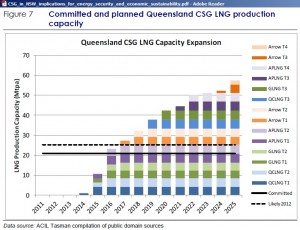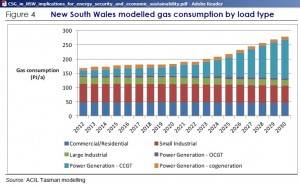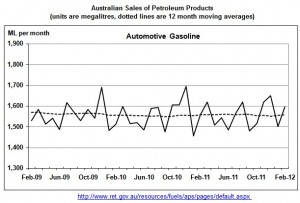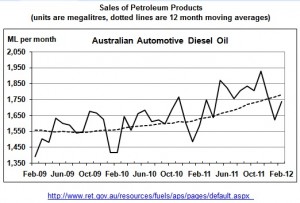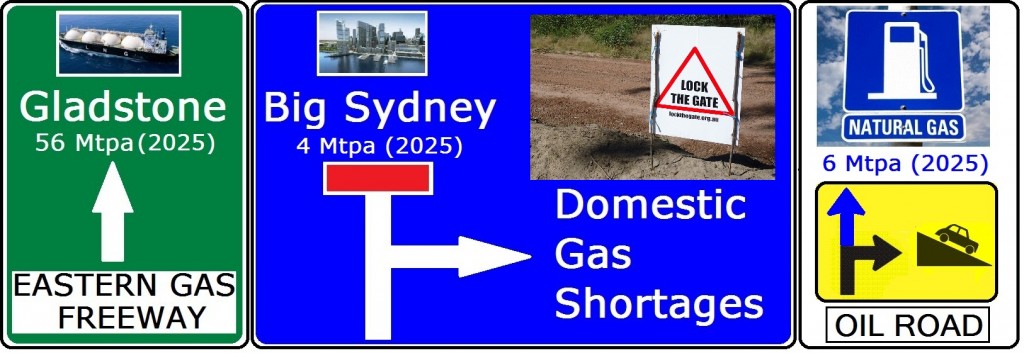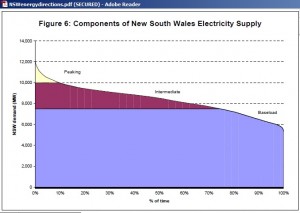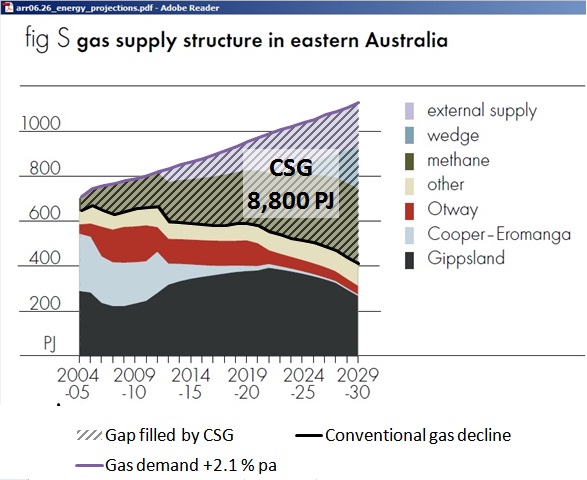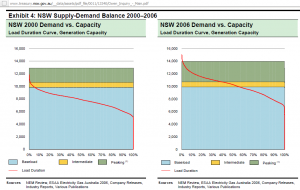Australia, wanting to project itself as the energy super power, faces domestic gas shortages in its Premier State, New South  Wales. This is what the public is made aware of in articles in the Sydney Morning Herald titled “Gas supply to dwindle in the next 2 years” and “AGL warns of shortage as Gladstone sucks up supply”. Is this just a strategy to soften up the opposition to coal seam gas development or is there really something more serious behind this news? This is the 3rd article in a series on natural gas. We read:
Wales. This is what the public is made aware of in articles in the Sydney Morning Herald titled “Gas supply to dwindle in the next 2 years” and “AGL warns of shortage as Gladstone sucks up supply”. Is this just a strategy to soften up the opposition to coal seam gas development or is there really something more serious behind this news? This is the 3rd article in a series on natural gas. We read:
In its submission to the federal government’s draft white paper on energy, the state government has warned gas could begin to run short in NSW from as soon as 2014, as long-term supply contracts from the Cooper Basin in central Australia begin to expire.
That’s how the expiry looks like, from a Gas Market Modelling Report of SKM-MMA for the Queensland Government:
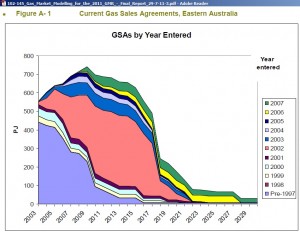 http://www.deedi.qld.gov.au/documents/energy/102-145_Gas_Market_Modelling_for_the_2011_GMR_-_Final_Report_29-7-11-3.pdf
http://www.deedi.qld.gov.au/documents/energy/102-145_Gas_Market_Modelling_for_the_2011_GMR_-_Final_Report_29-7-11-3.pdf
refers to a paper prepared by ACIL Tasman for Santos in March 2012, titled “Coal Seam Gas in NSW: implications for energy security and economic sustainability – a high level assessment”. In this document we find a graph with all LNG projects in Queensland, neatly phased and stacked:
and NSW gas consumption assuming that gas for electricity generation and co-generation will rise from 30 PJ pa to 151 PJ pa by 2030:
Please note that a 1,300 MW gas fired power station requires between 75 and 85 PJ pa (refer to Alinta submission to the Owen Inquiry) so the extra 121 PJ is just enough for one such power plant plus maybe 2 peaking power plants (also needed to compensate for variability of wind power) with much lower energy requirements.
Taking into account the gas supply situation the ACIL Tasman report then calculates the shortfall in the following table:
 From the above graphs we see the total 2025 requirement is around 220 PJ pa equivalent to 4 Mtpa of LNG (use the Santos conversion calculator http://www.santos.com/conversion-calculator.aspx ). This means that Queensland plans to export 57/4 = 14.25 times what NSW needs in 2025.
From the above graphs we see the total 2025 requirement is around 220 PJ pa equivalent to 4 Mtpa of LNG (use the Santos conversion calculator http://www.santos.com/conversion-calculator.aspx ). This means that Queensland plans to export 57/4 = 14.25 times what NSW needs in 2025.
ACIL Tasman is peak oil ignorant and has omitted of course the use of gas as transport fuel. How much would that be?
The above graph is from the Australian Petroleum Statistics http://www.ret.gov.au/resources/fuels/aps/pages/default.aspx
The average petrol consumption in Australia was around 1,550 ML per month. NSW has a share of approximately one third. With 34 MJ/litre the energy equivalent would be:
1,550 ML x 34 MJ/litre x 12 months / 3 = 210 PJ pa = 3.8 Mtpa LNG
Similarly, for diesel we have:
1,750 ML x 38 MJ/litre x 12 months / 3= 270 PJ pa = 4.8 Mtpa LNG
That gives a total of 8.6 Mtpa at present levels. Using trends of the last 3 years (zero growth for petrol and 4.8% pa for diesel) this would be 3.8 + 4.8 x (1+13*0.048) = 11.6 Mtpa for 2025. Let us assume we wanted to convert half of all petrol and diesel by 2025 that would be around 6 Mtpa. Let’s sum it up:
Road path depicting the yet undiscovered dilemma between LNG exports, NSW eternal growth plans, resistance to the “development” of coal seam gas in agricultural regions and oil decline.
Conclusion:
Resource nationalism is required. Australia is ruining its landscape in CSG projects for the benefit of other countries. And even the alleged CO2 emission benefits are doubtful as LNG in the destination country is not necessarily replacing coal. An immediate moratorium on new LNG export projects should be imposed. Energy hungry projects like skyscrapers, high-rises, convention centres, international hotels (as planned in Sydney’s Darling Harbour) should be abandoned. No new subdivisions should be added in Sydney’s hot West as this increases peak gas demand for electricity generators (air-conditioning). This means either decentralisation to regions with more favourable, less energy intensive climates, a reduction in immigration or both. As can be seen with these energy calculations the current Metropolitan Strategy will lead not only to petrol- and diesel- but also to gas- and power shortages.
Previous posts on gas as transport fuel:
13/10/2011
NSW gas as transport fuel. Where are the plans?
http://crudeoilpeak.info/nsw-gas-as-transport-fuel-where-are-the-plans
11/10/2011
Australia’s natural gas squandered in LNG exports
http://crudeoilpeak.info/australias-natural-gas-squandered-in-lng-exports
Appendix
History of gas shortage warnings
(1) In May 2004,Wood MacKenzie warned:
 http://www.apia.net.au/wp-content/uploads/2011/07/Vision-of-gas-supply-to-2020-John-Feenan.pdf
http://www.apia.net.au/wp-content/uploads/2011/07/Vision-of-gas-supply-to-2020-John-Feenan.pdf
(2) In June 2004, the Howard government published its Energy White Paper
It assesses the situation with a typical logical twist and clever semantics:
“Predictions are made that supplies of gas to major urban markets will run short in the next decade, as production in the Cooper Basin and Bass Strait declines. This has resulted in calls for financial support towards the building of major pipelines from either the Northern Territory (to access gas from Sunrise and other Timor Sea fields), Papua New Guinea or north-west Australia (to access gas from either Carnarvon or Browse Basins). While reserves of gas in existing fields close to southeast markets are declining, this does not represent an energy security concern. Exploration is occurring in the south-east and is resulting in new discoveries and development, such as in the Otway Basin. The development of coal seam methane is also increasing supplies of gas in the region.
In addition, holders of the large remotely located gas reserves are actively seeking markets to monetise these reserves. These efforts include actively investigating pipeline projects for bringing supplies of gas from north and north-west sources, as well as seeking LNG export sales in Asian markets. The number and activity of these competing proposals provide a degree of confidence that these supplies will become available once economic, noting that this will in all likelihood occur at higher price levels than those currently enjoyed in some south-eastern markets.”
(3) Then, in December 2004, the NSW Energy Directions Green Paper contained a chapter “Addressing the Emerging Demand/Supply Balance”
http://pandora.nla.gov.au/pan/48971/20050405-0000/NSWenergydirections.pdf
which started as follows:
“As outlined in chapter 2, in the absence of reductions in the rate of demand growth underpinning demand and supply forecasts, NSW is forecast to require new electricity generating capacity in the next few years.
Over the longer term, these forecasts imply that up to 6,000 MW of new supply, or demand reduction, may need to be realised between now and 2020” (p 15)
One of the problems mentioned was that peak demand for electricity had increased by 3.8% over 5 years (compared to an average demand increase of 2.8%), resulting in 10% of generating capacity (1,300 MW) used for only 1% of the time in one year.
The graph shows that 100% of the time at least 6,000 MW are needed but in very short peak times double of that, 12,000 MW. Peaking power demand is usually met with gas fired plants. But an even bigger problem is that the excess capacities in coal fired power plants built in the 1980s has been used up (without the public realising the underlying problems)
“The high gas price reflects the limited availability of gas in NSW and in eastern Australia more generally. NSW does not currently have significant developed gas reserves within its borders, and existing pipeline capacity into NSW would restrict the potential for gas plant development to a few thousand megawatts of capacity.
For NSW to be able to rely on gas as a major source of energy in the long term, extra gas would need to be available from discoveries in eastern Australia, from deployment of coal seam methane reserves or from pipelines to PNG or the North West Shelf. Significant long term infrastructure commitment would be required to construct major pipelines or deploy local reserves, and these costs would need to be reflected in the end-price of electricity” (p. 19)
(4) In December 2006, ABARE published research report 06.26 with following graph.
http://adl.brs.gov.au/data/warehouse/pe_abare99001338/arr06.26_energy_projections.pdf
Conventional gas decline and the hatched CSG production has been highlighted by the author.
ABARE proposes to offset declining conventional gas with coal bed methane. Growth is only possible with “external supply” and a mysterious , unspecified “wedge” in the 2020s.
(5) In July, the Owen Inquiry into Electricity Supply in NSW goes into some more details.
Wood Mackenzie writes a report with the sub-title “Availability and Cost of Gas for NSW Baseload Generation”, coming to following conclusion:
- There is a reasonable expectation that there are sufficient gas supply resources to support the long term gas-fired generation capacity additions in NSW.
o Gas reserves replacement ratio over the last 5 years in Eastern Australia has been a healthy 260%,
with continued, strong CSG reserves additions expected in the medium term.
o Potential exists for significant gas supply from within NSW (CSG) although at this stage material production
is yet to be proven.
o Higher gas prices will support further exploration and development of gas resources.
- Additional pipeline capacity will be required to meet the growing gas demand in NSW.
- New gas fired-generation is marginally competitive with coal fired generation as baseload in NSW but only with the support of NGAC’s. This is due to the relatively high delivered cost (commodity plus capacity costs) of gas to potential generation locations in NSW.
- With possible implementation of a Carbon Trading scheme, gas fired-generation (at 75% load factor) would be competitive with coal fired generation for baseload in NSW with a carbon price of A$15-$30/tonne CO2 equivalent.
http://www.dpc.nsw.gov.au/__data/assets/pdf_file/0003/12882/expertrep2woodmackenzie.pdf
Well, none of the recommendations has been followed.
- Demand reduction. In the contrary, the Metrostrategy, which started with the Growth Centres Plan in late 2005, is based on continuing population growth, half of which is driven by an ambitious Federal immigration programme. Recently, we have heard the present NSW government aims at a big Sydney[1]
- New pipelines to bring gas from the North West Coast. Nil. All gas there is exported as LNG so that Howard could proclaim Australia as an energy super power[2]
- Coal seam methane on the east coast. Well, that is exported, too, from Gladstone, with Queensland wanting to overtake Western Australia.
And the “reasonable expectation” about sufficient coal-seam-gas supplies has been put into question:
New study predicts frack fluids can migrate to aquifers within years
1/5/2012
A new study has raised fresh concerns about the safety of gas drilling in the Marcellus Shale, concluding that fracking chemicals injected into the ground could migrate toward drinking water supplies far more quickly than experts have previously predicted.
More than 5,000 wells were drilled in the Marcellus between mid-2009 and mid-2010, according to the study, which was published in the journal Ground Water two weeks ago. Operators inject up to 4 million gallons of fluid, under more than 10,000 pounds of pressure, to drill and frack each well.
Scientists have theorized that impermeable layers of rock would keep the fluid, which contains benzene and other dangerous chemicals, safely locked nearly a mile below water supplies. This view of the earth’s underground geology is a cornerstone of the industry’s argument that fracking poses minimal threats to the environment.
But the study, using computer modeling, concluded that natural faults and fractures in the Marcellus, exacerbated by the effects of fracking itself, could allow chemicals to reach the surface in as little as “just a few years.”
Another report to the Owen Inquiry, by Morgan Stanley, highlights the problem of base power being increasingly used at full capacity:
http://www.dpc.nsw.gov.au/__data/assets/pdf_file/0004/12883/expertrep3morganstanley.pdf
It will be interesting to see how updated load duration curves for 2011 will look like, soon to be published by AEMO.
